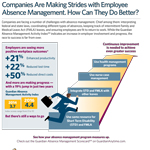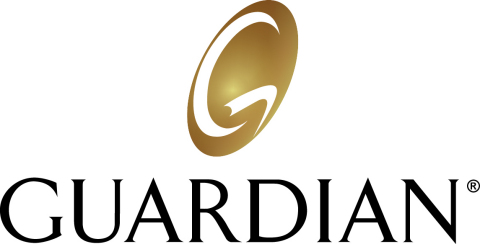NEW YORK--(BUSINESS WIRE)--The Guardian Life Insurance Company of America (Guardian), one of the nation’s largest mutual life insurers and a leading provider of employee benefits, today released the results of its 2017 Guardian Absence Management Activity Index SM and Study. The study highlights an encouraging improvement in key absence management metrics, with more companies reporting positive outcomes such as enhanced productivity (+21 percent), reduced lost time (+22 percent), and reduced costs (+50 percent).
Employee absences can lead to a decrease in workplace productivity and can have a significant impact on a company’s bottom line. The research shows that employers are making a conscious effort to reduce the impact of absences while dealing with the growing challenges of interpreting and complying with federal, state and local leave laws.
Nearly one-third of companies indicated that they are making a major effort to improve their absence management practices, up from 22 percent two years ago. As a result, the average Index score – a measure of the degree to which an employer is implementing absence management activities on a scale of 1 to 10 – improved to 4.4, compared with 3.7 in 2014 (a 19 percent increase).
Employers looking to achieve even greater success should focus on these best practices:
- Use the same resource to manage Short Term Disability (STD) and Family and Medical Leave Act (FMLA) leaves;
- Integrate STD and FMLA with other leaves;
- Consider nurse case management; and
- Incorporate health management programs (such as Employee Assistance Programs, wellness and health risk appraisals, and disease management).
“Absence management was once viewed as a concern only for large companies, but it is becoming a higher priority for small and medium-sized companies, and they are starting to reap the benefits,” said Scott Larsen, Vice President, Group and Worksite Markets at Guardian. “By outsourcing absence management activities, employers can alleviate the administrative and compliance burden on their human resource teams while reducing their risk, increasing workplace productivity and improving their bottom line.”
Notably, one in three employers now outsource both their STD and FMLA administration, twice as many as two years ago. And most of those companies use a single vendor to handle both leave types — more than double the 2014 level (28 percent vs. 12 percent). Employers are increasingly using insurance carriers as their vendor when outsourcing STD and FMLA administration.
Employers can use the Guardian Absence Management ScorecardSM to benchmark their leave management efforts against companies of similar size and receive a customized assessment of current absence management activities.
The Guardian Absence Management Activity IndexSM and Study can be viewed in its entirety at https://www.guardiananytime.com/gafd/wps/portal/fdhome/insights-perspectives/emerging-trends/absence-management-study-2017.
About the Survey
The Guardian Absence Management Activity IndexSM and Study is designed to measure the scope and effectiveness of absence management activities of both small and large employers. It was created to provide a better understanding of successful absence management programs and to clearly identify the most effective absence management activities employers can implement to achieve future success.
Guardian surveyed 1,000 benefits professionals working for employers ranging in size from 50 to 5,000 or more employees, spanning various industries and representing different geographic regions. All surveys were conducted online, and a threshold number of respondents were included in each employee size category to allow analysis of the results by organization size.
About Guardian
The Guardian Life Insurance Company of America® (Guardian) is one of the largest mutual life insurers, with $7.4 billion in capital and $1.5 billion in operating income (before taxes and dividends to policyholders) in 2016. Founded in 1860, the company has paid dividends to policyholders every year since 1868. Its offerings range from life insurance, disability income insurance, annuities, and investments to dental and vision insurance and employee benefits. The company has approximately 8,800 employees and a network of over 2,750 financial representatives in 58 agencies nationwide. For more information about Guardian, please visit our website, www.GuardianLife.com. You can also follow Guardian on Facebook, LinkedIn, Twitter and YouTube.
Financial information concerning The Guardian Life Insurance Company of America® as of December 31, 2016 on a statutory basis: Admitted Assets = $51.9 Billion; Liabilities = $45.7 Billion (including $39.4 Billion of Reserves); and Surplus = $6.2 Billion.




